#DM advice
Text
Want to know my spiciest d&d take as someone who introduces a lot of people to the game?
Classes (and subclasses) should be rated for complexity, and newer players should be steered away from overly complex options so that they're not asked to do double or triple the work of memorization of other players. This is especially true if the player is going to be slower to pick up on game mechanics, be they young, old, or simply not someone who's very experienced with games in general.
Think about it this way: everyone at the table is expected to learn the base game (what dice to roll, how to pilot their character by talking, actions in combat), some of which is written down but the rest being vibes based and mostly communicated through gentle coaching by the DM. On top of that a portion of your players are going to have to learn how spells work, effectively doubling or trippling their early game class features. This is to say nothing of druids, who not only have to learn all the base features and spells but also have to keep several different statblocks on hand when it comes time to turn into animals/summon familiars. If you have my luck, it's always going to be the shyest/most anxious player at the table who selects the most complicated class, paradoxically meaning the player who's least likely to ask for help is usually in most need of it.
I'm not saying we should restrict all new players to only playing vanilla human champion fighters, but I think a level of oversight is absolutely necessary when guiding new folks into the game. Consider running a trial adventure that's limited to martial classes, introducing a few magic items half way through to give them a taste of what spellcasting could be like.
Forget about the traditional Tank/dps/expert/support/caster party balance, that shit is for experienced players who know what they're doing.
333 notes
·
View notes
Text

No idea the source, but here have this.
Edit: Source is Pretendo Games. Thanks to @happilyeveraftereveryday for finding them!
2K notes
·
View notes
Text
A rule I have when DMing games is that a player can always choose to fail. If they think it'll make things more interesting or if it's funny or fits the character or if they just want to see what happens. Sometimes I'll give them a little reward for doing this, but I've found that once you establish that failing can lead to interesting consequences, players get on board.
453 notes
·
View notes
Text
If you ever feel like maybe it's a little embarrassing to do voices in d&d, like maybe you won't do it good enough or people will think you're weird, you will never be more embarrassed than my college rhetoric TA. This girl was maybe 23, tops, pale white girl with red hair, stood out in the room like a sore thumb. She was smart, don't get me wrong. Had the course material memorized (probably better than the professor, honestly). But the first time we went through the "lineage" of Greek philosophers and got to Cicero she busts out with the best Cicero (TeS) impersonation I've ever heard in the middle of the class. Not much, just a "what?! Cicero?!" Like someone was accusing her.
No one expected it. The Prof looked bewildered. She mumbled her explanation about how she and her bf had been playing a lot of Skyrim lately.
Anyway. Tl;Dr. You will never be more embarrassed than Cicero, my rhetoric TA.
#d&d#dnd#dungeons and dragons#ttrpg#dm advice#gm advice#doing silly voices is a gift#treasure those silly voices that your players and gm do
326 notes
·
View notes
Text
if you are a dungeon master (or even a fantasy author/worldbuilder of any kind) and you don’t know about donjon let me make your life a million times easier
want to make a fantasy calendar with your own year-lengths, weeks, months, and lunar cycles? https://donjon.bin.sh/fantasy/calendar/
need to come up with some medieval town demographics? https://donjon.bin.sh/fantasy/demographics/
want to make a map and layout of a city/town? https://donjon.bin.sh/fantasy/town/
want a fleshed-out tavern complete with menu, innkeeper, patrons, rumors, and secrets? https://donjon.bin.sh/fantasy/inn/
leading your players through a dungeon and want to customize the size, treasure, layout, theme, etc? https://donjon.bin.sh/5e/dungeon/
tired of creating lists of magic items for different shops to sell, or hoards to be looted? https://donjon.bin.sh/5e/magic/shop.html and https://donjon.bin.sh/d20/treasure/
even a customizable initiative tracker! https://donjon.bin.sh/d20/initiative/
and that’s only scratching the surface! I really recommend all dms check this out. oh, and it’s completely free!
#donjon#dm#dungeons and dragons#d&d#gm#worldbuilding#cr#dm tips#dm advice#ttrpg#game master#dungeon master
481 notes
·
View notes
Text

Is this balanced? A bard wanted to use this homebrew spell... I think it's a little bit too much damage, but I need help rebalancing
64 notes
·
View notes
Note
Curiosity question if you don't mind from a newbie dm. How do you deal with tpk as a dm ? Where you super stressed as it was happening or was it ok cause you could communicate with the players ?
this is the first time i've ever had a tpk happen. several things happened and several things contributed to the way i ran things and why i think my players are okay with the outcome and i'll talk about them now. some of these i think are tips that can be applicable to dming, some of them are just personality things, and some of them speak to group synergy.
i know this party well. i know the PLAYERS at this table that i was doing this campaign with well and we know how to communicate, 3/4 of us dm for each other and we are all typically good at knowing what each other will enjoy
we communicate well, even if it takes a minute out of session. for example, in another game we play where i'm a player some of the decisions i was making as my pc were bringing down another player, and while we all agreed at the start that it was okay, things changed, and so i changed the way i was playing my character and they're swapping out their pc for awhile to play a different character.
i think it's important to note with the two examples above, your mileage really will vary when it comes to communication with other people because one's capacity for interpersonal communication has nothing to do with their enjoyment of the game. likewise, you might have great friends but realize you don't enjoy playing d&d with each other. things happen.
i think something any ttrpg player can keep in mind is that just because you like someone doesn't mean you like playing a 4 hour board game with them once every two weeks and viceversa. just because you get along to play a game doesn't mean you need to be best friends with someone you don't feel that close to outside the game.
some actual thoughts of mine regarding tpks and what happened in session that i feel like made it a successful session instead of something that felt horrible and unfair
i did not make the encounter with the goal to kill my entire party or even to kill one of them. i wanted a hard fight, cr is hard to balance, usually you have to punch way above your party's weight class to have a fight feel scary and challenging. that is what i was doing. the fight was very winnable. it just came down to roll of the dice. i think they could've taken them down but that's just not the way it turned out. the encounter itself did not feel hopeless, that is important. the alternate to this is i am not against, as a dm, flagging that a fight IS hopeless and that the party should flee. that is run very differently than how i ran this encounter, i was not signposting for them to run, i thought they would win.
when the first player dropped and then rolled a nat1 i asked them this: by raw this is failing two death saves, however, if you want this to be an automatic death you can choose that. i do not want to choose for you, i want you to make the choice that is fun for you. pc death is not fun unless you have fun with it.
and then to keep a bit of mystery, i direct message'd them where i thought we could take their pc's story if they died / what the 'resurrection quest' could be. the player ended up deciding that auto death could be fun.
at this point, i did not know that i would successfully knock the other two players. and when it became clear that i could and was on the cusp of it, i asked them both something similar. do you both want to roll death saves and fight to the last breath or do you want to die. here's what will happen. they were excited by the death option.
my players chose to tpk. their characters did not, narratively they did not, the challenge was fair but hard and they failed narratively. failure should never be the end and should not be a punishment. the story moves forward. i presented an idea for where the story could go from the failure and they were enthusiastic about it.
after session i also checked in with the group and said, hey if you get second thoughts about this let me know and we can retcon that fight. i do not want to play a game that is not fun for you. as it stands now, they're all really excited about the idea of clawing their way back from the grave whenever we pick up a new story arc with those characters again.
and that's really what it boils down to for me as a dm whose spent a lot of time as a player in the game. pc death is not fun unless the player is excited about it. if they aren't okay with it, it will not be fun for anyone involved.
the game is about roll of the dice, the game is about story, the game is about mechanics and challenges and puzzles, but most of all it is about having fun. so if something is not fun, you don't have to do it.
i could talk forever about how i feel like there are some dms who take so so much pride in their intricate plots and ideas that they keep secret to their last breath without actually collaborating with their players which i think is actually a detriment.
#dm advice#i can talk more about my opinions on PC death in general and what i call 'resurrection quests' if you'd like and this is sort of a mismash#of my opinions on party synergy and above board communicaiton as well as improv from the dm chair.
91 notes
·
View notes
Text
A rant about roleplaying and taking advice from goblin eratta
Look, look, I get it. D&D is famous for its goblins and whatnot. But trust me when I say, pathfinder goblins are so much better art wise and writing wise than D&D's.
For example:
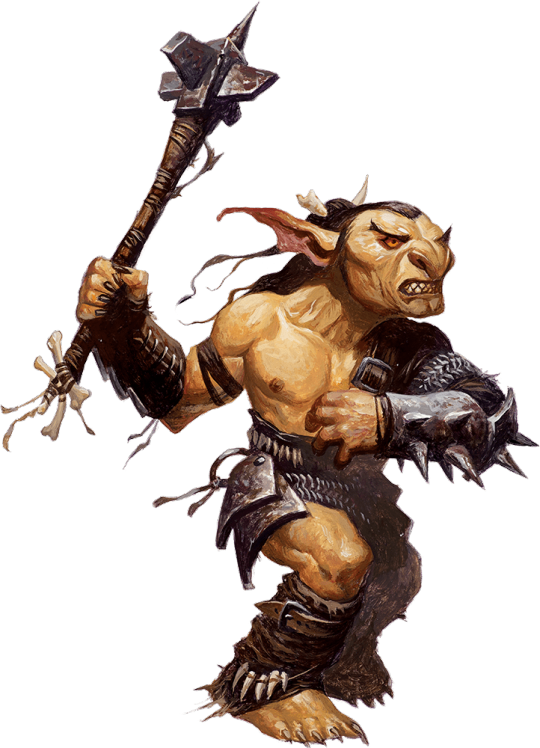
This is the D&D monster manual illustration for goblins.
Firstly, orange, chunky, this guy's has the aura of "might attempt tactics" about him. He looks more like he'd try and throttle you rather than run in fear at the sight of a large sword. The head is oddly shaped as a goblin's head should be, but it looks more lumpy warrior face than gobliny. The armor is far too organized. The ears are droopy and smooth. This is not goblin, this is a small ork at best.
Yeah they've got a brief section explaining the hobgoblins and bugbear relations, a little bit about goblin language, but not much as far as flavor text.
Now pathfinder goblins...

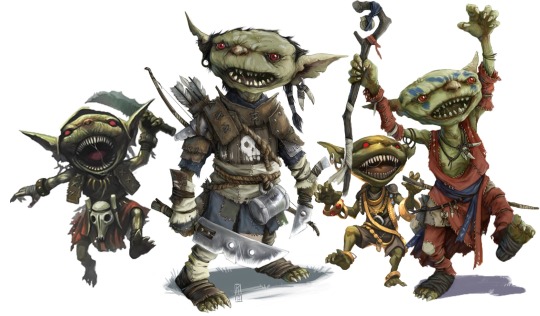
These are the quintessential goblin.
Green, scrawny, cowardly, chaotic, looks like they scrounge their clothes from local landfills, oblong football head, big ol' perky pointy goblin ears; *chefs kiss* perfection.
Pair that with the tidbits of goblin lore from pathfinder and ough you've got something good going on.
They are afraid of and have a burning hatred for horses. They typically wield 'horse choppers,' basically big cleavers or axes, instead of daggers or shortswords like in D&D.
One of the few occasions they'll organize and come up with plans is if they're pulling pranks or massive attacks under the command of a warlord or leader, of which they will occasionally get on accident.
They don't have to be bound to a leader, though, sometimes goblin bands can manage just with cooperation alone.
Goblins are crafty little buggers, laying traps and building ramshackle contraptions to get the jump on their foes. They prefer going for sneak attacks or surprise attacks over head on combat. They know they can't win a fair fight, so they fight unfair.
If you invade a goblin dwelling, they'll usually retreat on sight, but not always because of cowardice. Sometimes, they do so to lead you into their traps or to get you into a bottleneck. They can come up with strategies, but usually only if it's below the belt and breaks all the rules of engagement.
War crimes and chaos, if they aren't committing one of the two, they must be defective goblins.
There are occasions in the pathfinder modules where it encourages the DM to have the goblins get into antics over attacking the players. One such example is during a fight at a festival, it reccomends having some of the goblins focus on the festival food over the potential threat of the player characters, since they'd find the food much more important.
Some I came up with include swinging from ropes and attempting to grab players' hats, hoods or helmets, having some attempt to crawl into the clothes of the players instead of attacking, or even just crawling and wallowing all over them like opossum babies. My personal favorite and what got a huge laugh out of my players was having one find a big cast-iron stew pot and putting it on its head. It made it blind, but it also gave it more armor, making it sort of run at the characters to attack but not being able to hit them because it couldnt see, and the swords and maces bouncing off the pot due to the additional armor made it difficult to kill him. Pair that with the constant deafening the goblin would endure with the "bong" sounds any impacts would make, causing it to panic and run around more, bumping into walls and people alike.
What I love about these little tidbits of fight modifications is that it exemplifies the "combat doesn't mean roleplaying is over" factor many players and DM's either have never considered or just miss entirely. Many people complained that "man, if only combat in D&D was like the movie," and to that, I say: it can be, if you stopped being boring and made it that way! Describe what your character does! Add flavor to it! An action is 6 seconds. You can do so much in six seconds while still attacking! Describe the actions you take! Take free actions to do little flairs or flourishes! Show off! Fight with elegance, fight with brutality, fight with conniving, fight with confidence! Spend an action doing something in character instead of attacking! Yes, it's not efficient, but it's more interesting and entertaining to take a fall for a storytelling moment instead of spending yet another turn attacking. Flawed moments are far more interesting than constant perfection, that's why you use dice instead of always having a nat20 every turn. Use the failures to your advantage, show how your character reacts to a bad situation or rough luck!
Don't just spend the time in between your turns waiting for yours to roll around. Instead, be planning the sick ass thing you'll do if the dice allow you to, or the reaction to the adversity if they don't! And, sometimes, break away from the "I swing my sword, I cast a spell, I eldritch blast" combat! Push enemies off of elevations with the push action! Flip a table over to get cover from spells and ranged attacks!Grapple them to make it easier for your team mates to hit them or use them as a human shield! Grab a big rock off the ground and chuck it at someone! Cast a spell that doesn't just do damage!
Broke:
"You shoot a fireball at the thief as he attempts to escape."
Woke:
"As the the thief runs, I go to launch the fireball at him, but notice the mirror to the left of me. My narcisim gets the better of me, and I end up taking a second to check my hair. Ah yes, dashing. Oh, wait, I was doing something. I manage to tear myself away from the mirror long enough to barely catch the thief in my fireball as he attempts to flee."
So, I say all that to say this: players and Dms alike, roleplay during combat! It's a roleplaying game, not a roleplaying game+formulaic tabletop war game any time there's combat. And hey, if you ever find yourself needing inspiration on how to make fights more interesting in your tabletop games, grab a couple low level modules off Paizo, and read up on Pathfinder goblin scenes, they pay extreme dividends.
#skitposting#dungeons and dragons#d&d#pathfinder#goblins#roleplaying advice#roleplaying#dm advice#player advice
158 notes
·
View notes
Text
DM Pro tip - the "Recap" at the beginning of your session is your excuse to be EXTREMELY passive aggressive to your players and what they DIDN'T do.
#dungeons and dragons#being a dm#out of context stuff#dying inside#someone help me#brennan lee mulligan#critical role#lol#DM tips#dm advice#dungeon master#dnd campaign
88 notes
·
View notes
Text
Hey all, This is my first Tumblr post ever! I'm pretty new here, but I'm hoping to share some DM techniques, tools and tips and to make some new friends as well! Feel free to send a chat request (an ask[?]) if you're interested!
With that aside, on with the post!
Better and More Meaningful Random Encounters!
Random encounters are a staple of DnD, they are expected to be there during exploration as a way to make the world feel alive, to have it have an aura of adventure and danger, to eat up party resources and put pressure on the PCs to make interesting and important choices, and also as a way for a DM to reasonably 'stall' the party with a quick and easy situation.
Usually, it ends up something like this:
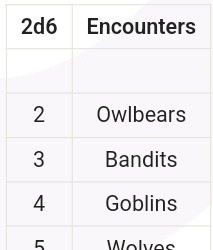
There's just one problem with most random encounter tables though, it's so easy for them to be GOSHDARN BORING! Especially for a newer DM.
Making them interesting becomes gambled improv on the DM's part if they're not used to it, and it's hard to keep track of the important factors that need to be kept in mind
Luckily, I ended up finding a great source for random encounters from 'Dungeon Masterpiece' on YouTube, and I integrated it into my own DMing. I figured that I'd share it here for any that want to work it into their own sessions as well!
After adjustment, a single table can account for multiple entire sessions of in-depth worldbuilding and fun without getting dull!
Sources:
Source 1 (Creating interesting Random Encounter Tables):
youtube
Source 2 (Making Random Encounters reflect your Worldbuilding):
youtube
There's 4 major methods we can use to improve the Random Encounter table
1. Make the table a straight 1dx roll.
2. Adding 'depth'.
3. Adding meaningful encounters.
4. Prerolling and/or Multirolling.
You can also check out the "Where to Start?" section for some direction to make getting it down and prepped all easy peasy!
1. Straight Roll:
Its enticing to go for 2d6 or the such in order to add non-linearity to the rolls, but these sorts of adjustments only end up making one or two encounters extremely likely and leave all others in the dust, it often ends up defeating it's own purpose of interesting randomness.
In the previous example, it was extremely likely to only get Wolves, Barbarians, Orcs, or Spiders, from a table of 12! A straight roll would serve us much better. The rare rolls are already rare enough as is!
Simply enough, adjusting the original example by replacing the 2d6 with 1d12, it'd become something more like this:
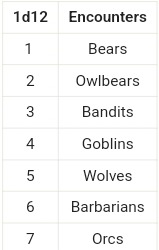
#2. Adding Depth:
We can add more columns in the encounter tables. These columns will represent different aspects about the encounters that we can roll on separately!
Usually it can be difficult as a DM to naturally come up with motives for the encounters, showcase the worldbuilding and have it all come together.
This setup can give you a solid guideline on how the creatures/people think (if any), and also sets up the overall area so that you get an idea of what events tend to occur there as a result of its occupants.
We want to add 3 more columns to the tables to convey different aspects of the encounter. Fill in these new columns corresponding to the expectations of each encounter.
We'll roll each of these and combine them, then we'll interpret them to make a robust, in-depth random encounter with truly unexpected results!
I recommend rolling alot of complete encounters at once and interpreting the context to the vast general area the party is travelling in.
i. Behaviour: How the creatures act. Are they friendly, scared, aggressive, curious, mischievous?
ii. Complication: Something behind the scenes in the encounter. Do they have sick young? Broken equipment? Are they starving?
iii. Significant Impact: This is a tick box, and will only be present under ONE of the rows. It will be rolled like the other columns, but ONLY once. It signifies which encounter is the Significant Encounter
The Significant Encounter will have its encounter's presence prominent amongst all the other random encounters in the area. There could be burn marks and carcasses from a rampant dragon, or a goblin raid leaving tracks moving through the area. Which is the most impactful of the different encounters?
Adding this to our previous example would expand it to:
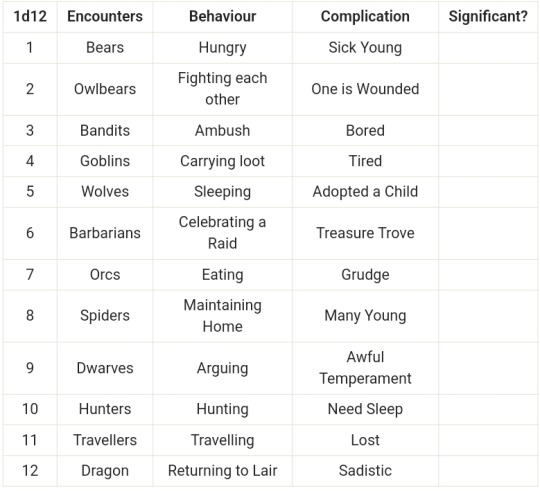
Rolling this would give us things like:
Significant encounter: Owlbears

Note that the significant impact shows that the Owlbears are a massive problem in the area. Perhaps the Owlbears are agitated for an unknown reason, and are unnecessarily aggressive.
The significance of Owlbears gives us context to the second one as well! Perhaps the hunters raided an Owlbear den, and adopted an Owlbear cub from there as well.
There could be uneaten carcasses, ravaged trees, less wildlife, etc around these parts.
Note how much sheer CONTEXT these columns add to our encounters. It's invaluable!
3. Adding Meaningful Encounters
Usually random encounters tend to be rather mundane and very one-note.
There's usually some general wildlife and monsters, different disparate factions without any rhyme or reason, and maybe a general non-combat encounter or two, but these don't really tell us about the area or its surroundings at all by themselves.
Instead, we can add in wildlife and monster encounters specific to the biome, non-combat encounters, and encounters of nearby factions and/or settlements to the table, and we can even add environmental encounters in there as well.
Note that we're not tied down to 12 encounters, and can expand it ad infinitum according to our need of diversity in our encounters.
Just add in specification and connection, and suddenly the dominos all fall into place.
Lastly, we'll also be adding in 'DOUBLE TIME' which will let us roll on everything twice, and make it so it's a double encounter!
Thus, the table can instead be adjusted to:
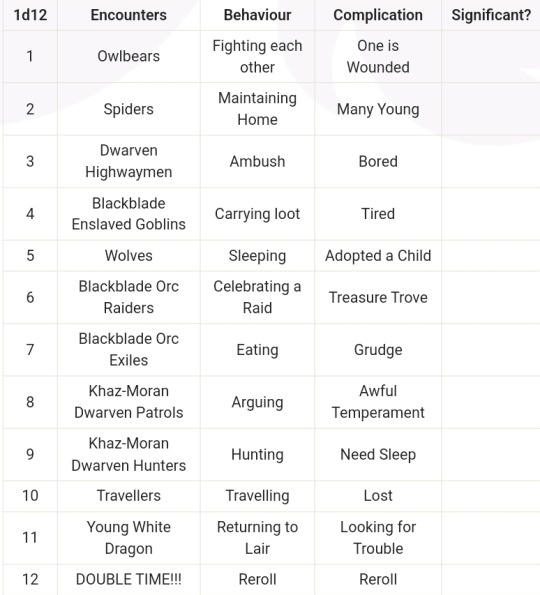
Note how each and everything has its relation in one way or another, but through the sheer variance, they remain truly random and novel.
4. Prerolling and/or Multirolling
Lastly and this is just something that I do, but that I found gamechanging. Be sure to pre-roll 5-7 encounters for each session, for the general area the players are going to be headed in.
Note that you don't need to really prep anything at all, just interpret all of them on a surface level as a buffer.
Also note that you don't need to use all of them if they're not needed. The foreshadowing and signs are worldbuilding and having secrets that the players don't unravel is just as useful as the ones that they do, perhaps even moreso. It adds depth and detail beyond the scope of what the party will encounter
It simply let's you get an idea of the connections between encounters, allows for foreshadowing, and acts as a deterrent to getting caught off guard.
Even if you roll mid-session, I recommend calling for a 5 minute break, rolling 5-7 encounters at the same time and interpreting them and their connections before resuming the session.
It WILL make a difference, trust me
Where to start?
It can be difficult getting inspiration or direction to get started in creating these random encounters, and sometimes you don't want to go through the hassle of thinking them up from nothing
For some great conceptual headstarts and examples for these tables, you can check out 'Worlds Without Number' and it's:
- Page 205 (Great general templates for encounters differentiated by broad creature types such as Beasts and Monsters, Sapient Monsters, and Humans)
- Pages 206-219 (For inspired locations to occasionally run rare encounters or groups of encounters in. This works best with flexible/discovered worldbuilding given the significance of some of these, and you also want to add these in sparingly to keep them significant)
- Pages 246-247 (These pages have great templates for the kinds of encounters and situation to be included in the tables, and it can be expanded vastly, and certain options can be selectively and repeatedly chosen to meet our needs. Mood works well as a complication.)
There might be other pages that are useful as well for these sorts of random encounters in the wilderness that I haven't come across yet. If so, give them a shout out and I'll be sure to add them in. It's worth checking it out in its entirety for some great tips!
Conclusion
Again, credit goes to Dungeon Masterpiece and Worlds Without Number for excellent adjustments. This has been quite long, but I hope you stuck around till the end.
Many a session have been made easy but complex ever since this was introduced and I hope that this helps you out as much as it helped me in my prep and improv!
Feel free to give any advice in formatting on Tumblr, or any feedback on the post itself. It really means a lot to me, thanks!
#dm tools#dungeons and dragons tips#dungeon master tips#dm advice#dm tips#ttrpg#dnd#Youtube#dnd resources#gm tips
58 notes
·
View notes
Text

what do you think?
pointsofinspiration.com
#dnd#dungeons and dragons#ttrpg#dungeon master#dm tips#dnd5e#dm advice#pathfinder#fantasy#dungeon master tips
93 notes
·
View notes
Text
I often see references to the concept of a Forever DM in discussions of my favorite hobby. A hapless person who would love to play D&D, but is forced to forever manage campaigns instead because they don't know anyone else who will step up to do it.
I feel fortunate to not have experienced this in my own life. In the gaming groups I've been a part of, there's always been a rotation of Dungeon Masters, with multiple people happily volunteering to run the next game.
Perhaps I'm just very lucky, but I also feel like the concept of a Forever DM the way it's usually presented is kind of like a self fulfilling prophecy. If you see DMing as a chore that needs to be done in order to facilitate the fun of others, you're not really presenting it as a desirable role. You're discouraging others from giving it a try. And it's a shame too, because being a Dungeon Master is genuinely very fun and fulfilling. And it's something you can spend years honing your technique and getting better at, but you don't need to be an expert to enjoy yourself. The process of practicing is itself very enjoyable.
So I guess what I'm trying to say, is that if you see yourself as the Forever DM, and that's not something you want to be, than you should try reframing your own perception about the role. The DM is a player too, and the more fun you have, the more likely someone else is going to see you and say "I'd like to try that".
168 notes
·
View notes
Text
DM\GM Tip on Roleplaying Stuff
🎲 GMs, there’s always a way to say yes to what the player wants to do.
🎭 Roleplay isn’t always about getting what you want but being given the chance to try and it doesn’t mean success is always possible.
💪 I once had a Barbarian whose whole purpose was to fight the biggest things he could find.
🌋 The first time he saw a Volcano, he wanted to fight it. Both me and the player knew that wasn't possible. But I gave him the chance to play this out.
He attempted to scale the side while his party looked on, dumbfounded. He eventually fell...multiple times. Until he swore, he would return when he was stronger to exact revenge.
Sometimes players will want to do things and not understand that it's not possible yet -- could be due to power levels, influence, ect.
🧙♀️ Don't just deny them the opportunity. Talk, communicate expectations and give them chances to work towards those goals.
#Dungeon Master#Game Master#DnD#D&D#Dunngeons & Dragons#Dungeons and Dragons#TTRPG#DM Tips#GM Tips#DM Advice
115 notes
·
View notes
Text
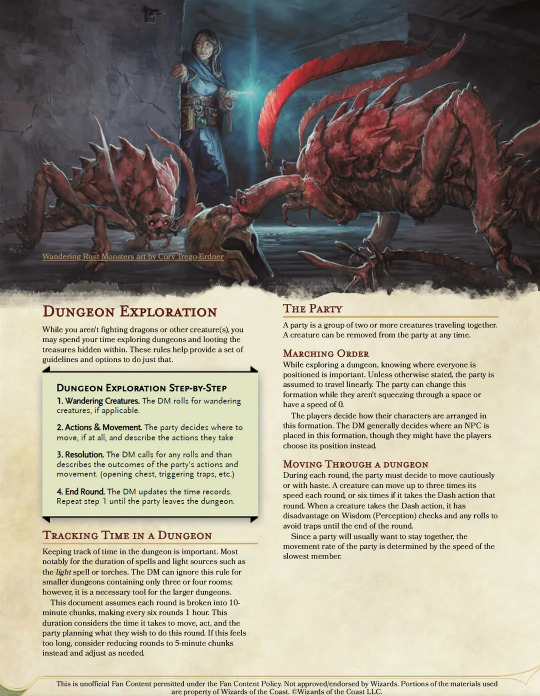
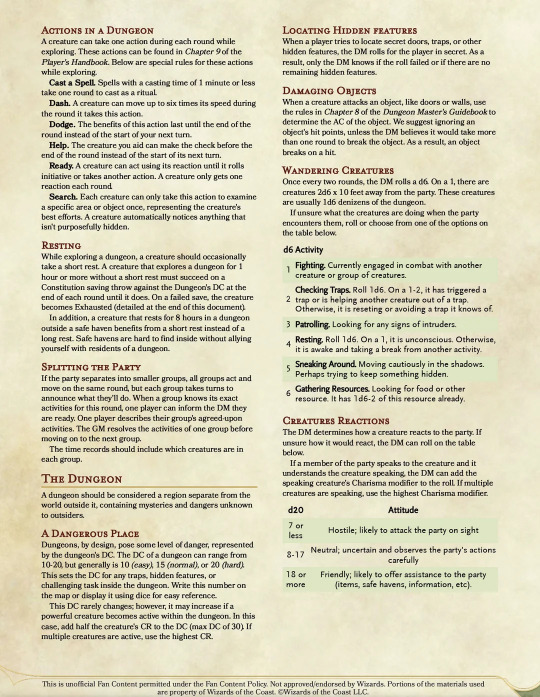
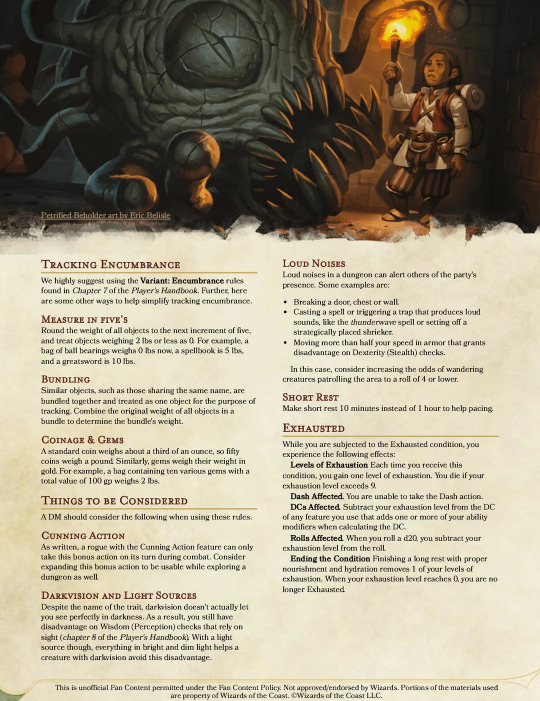
Dungeon exploration by O-kra on reddit
57 notes
·
View notes
Note
any spare tips for first-time DMs? (can be about anything — or like, what’s something you wish someone told you when you first started DMing?)
yknow how when postgrads reflect on uni and they're like OH my god do the reading. just do the reading just shut up and sit down and do the reading. d&d is very much the same principle. just read the module. just read it over and over and over again. highlight the important bits. just prepare the statblocks and read them over, no AGAIN and then reread the module.
or, if you're homebrewing almost entirely. just write the thing. find every name generator and treasure generator and every other generator you could need and write the thing. steal RUTHLESSLY. if you're not recording it as a podcast or making a profit from it just take from everything. take entire plots of books or movies or tv shows (the more obscure the better, especially if your players haven't read/seen it) and copy the parts you like. do you think you could have written a better adaptation of a niche fantasy novel? fucking PROVE IT. and then PUT YOUR PLAYERS IN CIRCUMSTANCES. read other tabletop systems!! use dmsguild for the love of FUCK use dms guild. pirate other d&d modules (and look back at earlier editions!!! there is some gold in 3.5e). DON'T think you have to come up with theeeeee most unique and original and special d&d world literally no one is paying you to do that and copyrighting is for losers. this is fun times at your dining room table/desk. search "d&d maps" on pinterest or search for unique and rare items for loot, and then base entire campaigns around these set pieces. i ran a 10 or so session campaign around each member of the party fighting someone who owned an artifact or relic that fit each of their builds and then upon gathering these items they fought a ghost council of guild leaders and apotheosised themselves into their place on accident. and it was FUN.
106 notes
·
View notes
Text
Borrowing mechanics from other rpgs, I've been using the idea of uses for the various packs in dnd rather than having my players track each individual resource. It's brought more use to the mundane items you start with.
Basically, a dungeoneers pack has 5 uses rather than a set list of items. A player can spend a use to pull any item of their choice that could reasonably be in a dungeoneers pack such as 50-feet of rope or a dozen pitons. An item remains until they recover the uses of their pack which recovers uses whenever they visit a town or trader and spend the necessary currency to do so.
This has made the sore spot for my players that is remembering what items they have much easier for them. It also eliminates the problem of holding on to items in case you might need them for a scenario that might never happen.
46 notes
·
View notes